Mia Liu’s (劉文瑄) first performance art piece took place at New York’s Guggenheim Museum. Well, kind of. Liu, 31, had been working at the museum as a ticket taker while doing an MFA at Hunter College when she came up with the idea of printing the title of her own show on the museum’s tickets. Fearful of losing her job, however, she only handed out a few. She then came up with another plan — to display her work in the museum’s staff room.
“Then I could put on my resume that I’d had a solo show at the Guggenheim,” Liu said. She approached her boss with the idea, “and he looked at me like I was crazy,” she said.
It’s unfortunate Liu didn’t take either action to any kind of conclusion because it would have subverted the museum’s curatorial policies, raised interesting questions as to how artists exhibit at major art museums and offered a reconsideration of what constitutes museum space (should we consider a staff room part of Guggenheim’s exhibition area?).
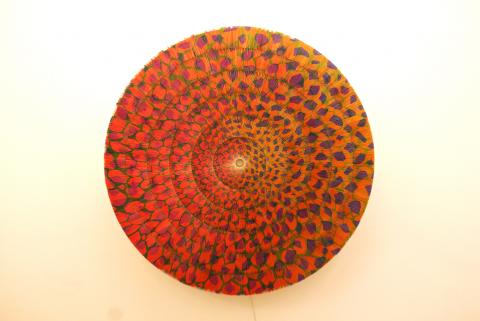
Photo: Noah Buchan, Taipei times, and courtesy of Mia Liu
Though an official Guggenheim show has yet to materialize for Liu, she did convince the museum to sell her 200,000 of its tickets, 60,000 of which she has used in Guggen’ Dizzy, a large-scale trompe l’oeil sculptural triptych currently on view at IT Park. The sculpture is part of I Can’t Tell You, but You Feel It (我無法告訴你), a solo show of her work that includes photography and installation. This review focuses on the sculpture.
Guggen’ Dizzy appeals because its simple elements combine in a way to create complex visual illusions reminiscent of optical art. Liu began the work with a series of doodles, sketches and drawings of basic geometric objects, scanned the bits into a computer and pieced them together to form a template of the sculpture’s overall design.
With the help of assistants, she attached, one by one, 20,000 tickets to one of three circular boards, each made up of six concentric circles. Colored masking tape was stuck to the edges of the tickets, that when combined form the original patterns. The boards were then mounted onto metal brackets and clamped onto a motor, which when switched on rotates slowly. The three-panel sculpture took three years to complete.
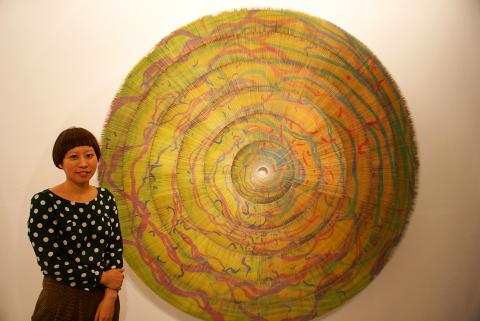
Photo: Noah Buchan, Taipei times, and courtesy of Mia Liu
Watching the sculptures rotate is a thing to behold because the colors and shapes constantly shift depending on how light is refracted off their surfaces. Are they a kind of mandala, meant as a prompt to contemplate the flux and impermanence of existence? Or perhaps their constantly changing appearance is a metaphor for the contingency of human perception.
Liu offered a more mundane explanation.
“It’s just about mixing different colors with light [based] on patterns that I draw on a daily basis,” she said.
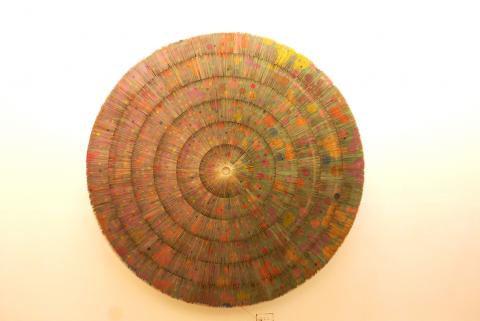
Photo: Noah Buchan, Taipei times, and courtesy of Mia Liu
Reflecting on the exhibit’s title, Liu’s meaning becomes clear. We aren’t supposed to use our reason to look for any deeper meaning, but feel and experience the sculpture’s aesthetic beauty.
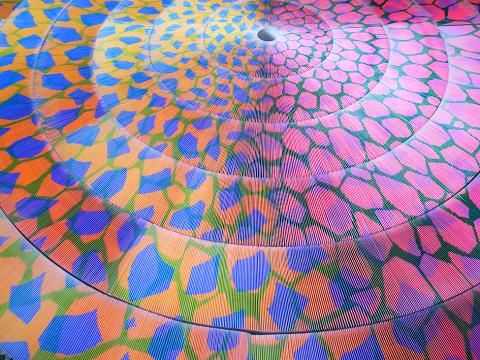
Photo: Noah Buchan, Taipei times, and courtesy of Mia Liu
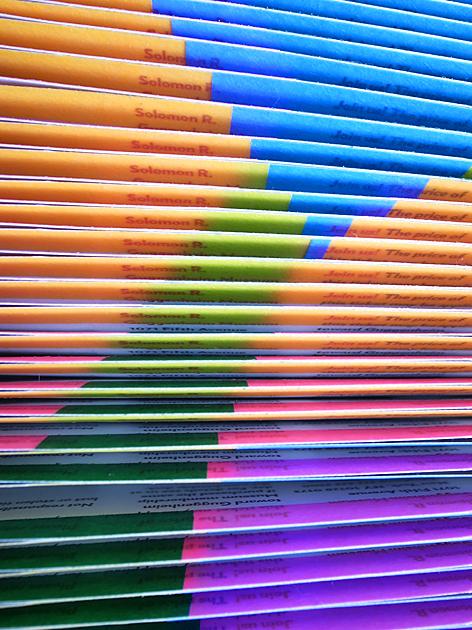
Photo: Noah Buchan, Taipei times, and courtesy of Mia Liu
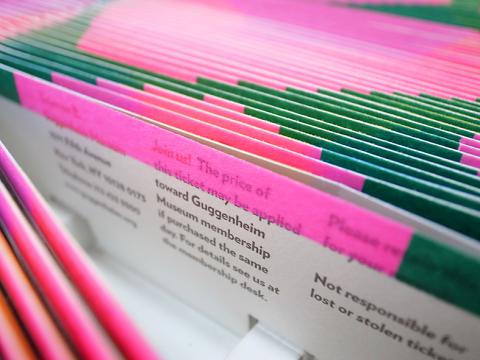
Photo: Noah Buchan, Taipei times, and courtesy of Mia Liu

On April 26, The Lancet published a letter from two doctors at Taichung-based China Medical University Hospital (CMUH) warning that “Taiwan’s Health Care System is on the Brink of Collapse.” The authors said that “Years of policy inaction and mismanagement of resources have led to the National Health Insurance system operating under unsustainable conditions.” The pushback was immediate. Errors in the paper were quickly identified and publicized, to discredit the authors (the hospital apologized). CNA reported that CMUH said the letter described Taiwan in 2021 as having 62 nurses per 10,000 people, when the correct number was 78 nurses per 10,000

As we live longer, our risk of cognitive impairment is increasing. How can we delay the onset of symptoms? Do we have to give up every indulgence or can small changes make a difference? We asked neurologists for tips on how to keep our brains healthy for life. TAKE CARE OF YOUR HEALTH “All of the sensible things that apply to bodily health apply to brain health,” says Suzanne O’Sullivan, a consultant in neurology at the National Hospital for Neurology and Neurosurgery in London, and the author of The Age of Diagnosis. “When you’re 20, you can get away with absolute

May 5 to May 11 What started out as friction between Taiwanese students at Taichung First High School and a Japanese head cook escalated dramatically over the first two weeks of May 1927. It began on April 30 when the cook’s wife knew that lotus starch used in that night’s dinner had rat feces in it, but failed to inform staff until the meal was already prepared. The students believed that her silence was intentional, and filed a complaint. The school’s Japanese administrators sided with the cook’s family, dismissing the students as troublemakers and clamping down on their freedoms — with

As Donald Trump’s executive order in March led to the shuttering of Voice of America (VOA) — the global broadcaster whose roots date back to the fight against Nazi propaganda — he quickly attracted support from figures not used to aligning themselves with any US administration. Trump had ordered the US Agency for Global Media, the federal agency that funds VOA and other groups promoting independent journalism overseas, to be “eliminated to the maximum extent consistent with applicable law.” The decision suddenly halted programming in 49 languages to more than 425 million people. In Moscow, Margarita Simonyan, the hardline editor-in-chief of the